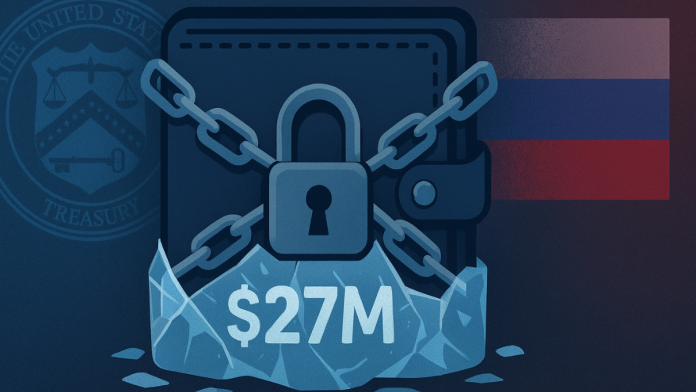The U.S. Treasury has rolled out a new sanctions package aimed at Russian-linked crypto platforms. As part of this move, around $27 million worth of the stablecoin USDT has been frozen. The action targets two exchanges, Garantex and Grinex, which American officials accuse of enabling illegal financial activity.
This step is not just about the money. In fact, $27 million is a small amount in the global crypto market, which trades in billions every day. The real importance lies in the message sent. It shows that crypto platforms, even those outside the U.S., can be reached by the Office of Foreign Assets Control (OFAC), the enforcement arm of the Treasury, if they are believed to be involved in suspicious activity.
Garantex, already blacklisted in 2022 for connections to ransomware, has once again been linked to questionable financial flows. Now, with Grinex also in the spotlight, the sanctions are a reminder that Washington is closely monitoring crypto channels that may be used for crime or to sidestep global restrictions.
Crypto mining scam worth $577 million ends with prison for Estonian duo
The timing is notable, coming just as Donald Trump and Vladimir Putin have been holding talks about possible peace negotiations. This adds a political weight to what may otherwise look like a modest financial freeze.
Market Reaction: Calm Despite Sanctions
Despite the headlines, the impact on global crypto prices was close to zero. Both Bitcoin and Ethereum, the two largest cryptocurrencies, stayed stable after the announcement. There were no sudden price swings, no major spikes in trading, and no signs of panic in the market.
Trump says India has reduced Russian oil imports and warns of secondary tariffs
This is similar to what happened in 2022, when Garantex was first sanctioned. That move also made waves in the news but did not shake the global crypto market. Analysts point out that only major policy changes in places like the U.S., Europe, or Asia usually affect the prices of Bitcoin and Ethereum. Small exchanges in Russia or elsewhere do not hold enough power to move the market by themselves.
For ordinary investors, this means the news was more political than financial. Crypto continues to trade as usual, and the world’s biggest coins have not been shaken by the latest sanctions.
Tether’s Role Highlights Oversight Power
A key detail in the sanctions story is the role of Tether, the company behind the USDT stablecoin. Tether was able to freeze the $27 million linked to the Russian exchanges within hours. This shows how quickly stablecoins can be blocked if they are connected to illegal activity.
🇹🇷 Crypto kingpin falls — Turkey seizes ICRYPEX assets in explosive money laundering crackdown
For some institutional investors, this is a positive sign. It proves that there are systems in place to prevent large-scale money laundering through digital assets. At the same time, it also shows that stablecoins are not beyond control. They can be tracked, and they can be stopped if governments or regulators see something suspicious.
The decision highlights how crypto has become part of global politics. Sanctions are not only about banks or trade anymore; they now extend to digital currencies as well. While the frozen funds are small compared to the wider market, the move underlines how the U.S. can work with private companies like Tether to enforce its policies.
By repeatedly targeting platforms such as Garantex and now Grinex, Washington is sending a strong warning. Any exchange that deals with sanctioned groups risks being cut off. Even though these Russian platforms are on the fringes of global finance, the penalties serve to isolate them further.


